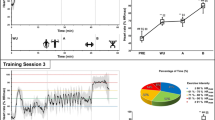Abstract
Background
Acrosport is a specific type of gymnastics executed in pairs or groups of athletes, characterized by static, acrobatic, and choreographic elements. Very few data are available in the literature on the physiological profile of acrosport athletes.
Purpose
The aim of the study was to evaluate the heart rate (HR) response to the different phases of a typical acrosport training session.
Methods
Twenty female acrosport athletes (13 bases and 7 tops) volunteered for the study. To assess the cardiovascular commitment and the percentage of HR utilized, data were averaged during the entire training session and for each training phase. Was calculated also the percentage of HR reserve for each training phase.
Results
HR response showed a statistical difference among the different training phases in both base and top athletes. Moreover, bases and tops had a significantly different HR response only in the individual phases.
Conclusion
The training phases during a typical acrosport training session revealed a different cardiovascular commitment during exercise. Differences between tops and bases were also retrieved and were probably due to the different level of experience and the different role played by tops and bases during the same combination of exercises.



Similar content being viewed by others
Abbreviations
- FIG:
-
Fédération Internationale de Gymnastique
- HR:
-
Heart rate
- HRrest :
-
Heart rate at resting
- HRR:
-
Heart rate reserve
- HRex :
-
Heart rate during a training
References
Almeida A (1994) Gymnastics Acrobática:iniciação na escola e no clube. Revista Horizonte Portugal 11(62):II–VIII
American College of Sports Medicine Position Stand (1998) The recommended quantity and quality of exercise for developing and maintaining cardiorespiratory and muscular fitness, and flexibility in healthy adults. Med Sci Sports Exerc 30(6):975–991
Arazi H, Asadi A, Nasehi M, Delpasand A (2012) Cardiovascular and blood lactate responses to acute plyometric exercise in female volleyball and handball players. Sports Sci Health 8:23–29
Da Cunha FA, Farinatti Pde T, Midgley AW (2011) Methodological and practical application issues in exercise prescription using the heart rate reserve and oxygen uptake reserve methods. J Sci Med Sport 14(1):46–57
Esposito F, Impellizzeri FM, Margonato V, Vanni R, Pizzini G, Veicsteinas A (2004) Validity of heart rate as an indicator of aerobic demand during soccer activities in amateur soccer players. Eur J Appl Physiol 93(1–2):167–172. doi:10.1007/s00421-004-1192-4
Nissen G (1991) Twenty advantages sports acrobatics has over gymnastics. Int Gymnast 33:36–37
Gallardo JSP, Azevedo LHR (2007) Fundamentos básicos da ginástica acrobática competitiva. Autores Associados, Campinas
Gymnastique FId (2013) Acrobatic gymnastics code of points 2013–2016.1,2,19,31
Hughes M, Crowley A (2001) Success in sports acrobatics as a function of complexity of skills time. J Hum Mov Studies 40(3):161–170
Hui SS, Chan JW (2006) The relationship between heart rate reserve and oxygen uptake reserve in children and adolescents. Res Q Exerc Sport 77(1):41–49
Marongiu E, Crisafulli A (2015) Gender differences in cardiovascular functions during exercise: a brief review. Sports Sci Health 11(3):235–241
Merida F, Piccolo VLN (2008) Ginástica acrobática: um estudo sobre a prática pedagógica. Conexões 6:367–376
Taboada-Iglesias Y, Gutierrez-Sanchez A, Vernetta Santana M (2015) Anthropometric profile of elite acrobatic gymnasts and prediction of role performance. J Sports Med Phys Fitness. Mar 06 [Epub ahead of print]
Tanaka H, Monahan KD, Seals DR (2001) Age-predicted maximal heart rate revisited. J Am Coll Cardiol 37(1):153–156
Compliance with ethical standards
Conflict of interest
The authors declare they have no conflict of interests.
Ethical approval
All procedures performed in studies involving human participants were in accordance with the ethical standards of the institutional and/or national research committee and with the 1964 Helsinki declaration and its later amendments or comparable ethical standards.
Informed consent
Informed consent was obtained from all individual participants included in the study.
Author information
Authors and Affiliations
Corresponding author
Rights and permissions
About this article
Cite this article
Limonta, E., Cavagna, M., Venturelli, M. et al. Heart rate response to different training phases in young female acrosport athletes. Sport Sci Health 12, 21–26 (2016). https://doi.org/10.1007/s11332-015-0249-6
Received:
Accepted:
Published:
Issue Date:
DOI: https://doi.org/10.1007/s11332-015-0249-6




